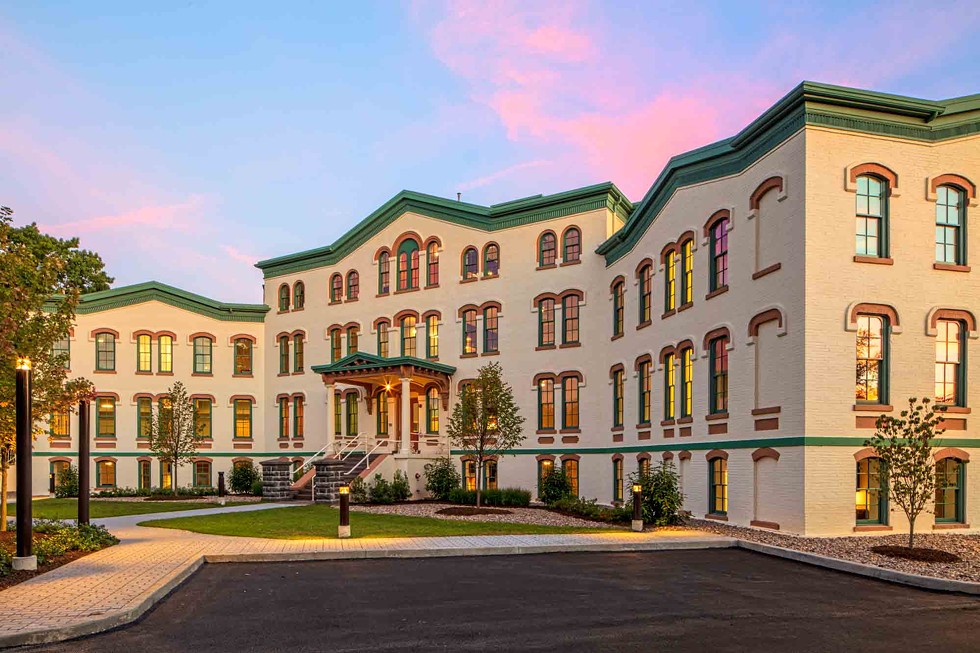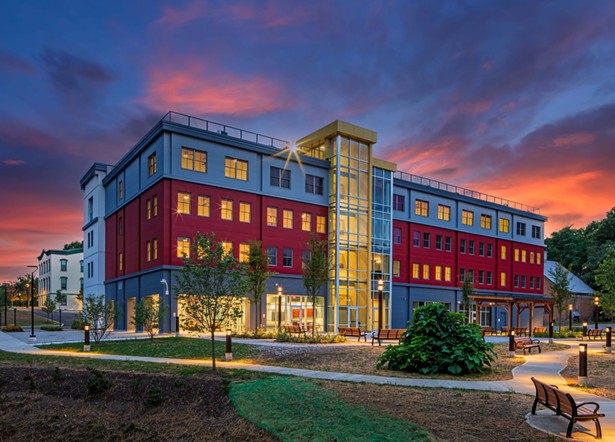As 2022 drew to a close, Suzanne and Kenny Pazurik were going into their 70s facing eviction. After both losing their jobs in the pandemic, the couple had dug into their retirement savings to pay for their apartment in Yonkers, but sharply rising rent prices had eaten away nearly the entire amount. Suzanne had been applying for housing lotteries, but she had only heard back from one organization—RUPCO—and she had been waiting on an apartment in Kingston from them for two years. When the Pazuriks finally got the call to move into Landmark Place, RUPCO’s newest senior housing building, they couldn’t afford the $3,000 moving truck. Suzanne called the Yonkers Department of Social Services to plead her case, and after listening to her story, they agreed to cover the cost. In late 2022, the Pazuriks moved into Landmark Place with $600 left between the two of them.
Kenny hadn’t wanted to leave Yonkers for Kingston, but after hearing the deal—a brand new one-bedroom apartment for $781 a month with free electricity and parking—he was understandably swayed. The Pazuriks had been paying almost $4,000 a month in Yonkers. “By the skin of our teeth, we made it up here without being evicted,” Suzanne says. “RUPCO should get a Nobel Peace Prize. I’d put them in the category of Mother Teresa. When you come up here and you sit down with them, they look at you like they want to help you any which way.”
Mike Atkin, 65, was living in a lean-to at a Park and Ride lot in Kingston near the New York State Thruway. He had left his apartment in Rockland County on Christmas in 2020, fearing for his life after his roommate’s continuous refusal to adhere to COVID protocols. In preparation, he had been buying camping gear and lumber using his monthly disability checks. He built a four-by-eight-foot flatbed trailer. and pushed it down the highway to the Park and Ride, where he set up camp in a tent. Due to the kindness of a superintendent, Atkin was allowed to stay there for six months, living on disability checks and eating at gas stations in a state he called “total survival.”
In November 2021, after a year of weathering the elements and stints of couch-surfing with his sister and his son, Atkin moved into Landmark Place. He had signed up for RUPCO’s senior housing lottery after seeing a sign in a window, and his ticket came up third. “I’m incredibly grateful, and it’s more than I hoped for,” Atkin says. “It’s hard to say what I hoped for, because I didn’t see an end to my situation. I wasn’t going to last too much longer if I stayed out there. In three years I’d look like a 90-year-old man, if I was alive.”
An Aging Population
RUPCO and Hudson River Housing (HRH) are major players in the affordable housing market of the Hudson Valley. Based in Kingston and Poughkeepsie respectively, the two community development nonprofits are pioneers in providing affordable housing to seniors, whose often limited incomes and health challenges make them vulnerable residents.
Affordable housing isn’t keeping pace with demand in the Hudson Valley and nationwide, and as the Hudson Valley and national population are aging, seniors constitute a large portion of that unmet need. Ballooning rent prices and inflation are eating away at retired seniors’ fixed incomes. Since 1989, the percentage of homeowners carrying mortgage debt has nearly doubled for those aged 65 to 74 and almost tripled for those older than 75. Add to this the end of the eviction moratorium in New York State in 2021, and many aging Hudson Valley residents are at risk of losing their homes. According to Dutchess County’s most recent Annual Homeless Report, adults over age 55 make up 17 percent of the local homeless population.
HRH office manager Robin Evans calls the supply of affordable housing in the Hudson Valley “woefully inadequate,” particularly impacting vulnerable residents like seniors. “The Hudson Valley has had the highest increases in housing costs in the country and is also facing extremely low inventory,” says Jennifer Welles, executive director of the Newburgh Community Land Bank, another regional affordable housing nonprofit. “Seniors have very few options for affordable housing that also have the amenities they need, like walkability, support services, and access to community services.”
Hudson and Kingston topped the New York Times’ 2021 list of metro areas with the biggest change in net in-migration during the pandemic. The large wave of higher-income buyers from New York City in 2020 and 2021 willing to pay above-market prices created a real estate frenzy that both drove up costs and reduced the housing stock available, as many purchased these previous rental properties with the intent to exclusively use them as second homes. In many areas, short-term rentals have since replaced a lot of the available long-term rentals, which would have provided more stable housing. The most recent Dutchess County Annual Rental Housing Report found that the vacancy rate fell to 0.6 percent in 2021—the lowest rate since the first edition of the report in 1980 and far below the five percent rate considered healthy.
“RUPCO’s mission to create homes, support people, and improve communities has never been more relevant,” says Maru Gonzalez, RUPCO brand manager and executive coordinator to the CEO. HRH’s mission—“housing with compassion and development with a vision”—is much the same. Founded one year apart, RUPCO (1981) and HRH (1982) have both worked to positively impact Hudson Valley housing for over 40 years.
A Long Way to Go
To date, HRH has added over 1,500 affordable units to the local rental housing market, and currently manages a total of 736 units that cater to seniors, veterans, and those experiencing homelessness. RUPCO maintains a 23-property, 751-apartment portfolio in Ulster, Orange, and Greene counties, which include senior, family, special needs, and artist rental units currently housing more than 1,000 people.
Landmark Place, completed in August 2022, is their biggest senior and supportive housing endeavor to date, totaling 66 units in two buildings on a 14-acre campus. Thirty-five of these units are for previously homeless individuals, who will also receive onsite services that include medication management, behavioral health support, and life skills training. One of the buildings is the historic Kingston Almshouse, which dates back to 1874.
Mike Atkin loves his Landmark Place apartment, a studio with high ceilings and big windows. “It’s the bare minimum real estate-wise of what you need to be okay, but I have it—and I’m okay,” he says. He gave a speech at the grand opening of Landmark Place, calling RUPCO “the gold standard of supportive housing.” The chairman of the Ulster County Community Service Board was in the audience and asked Atkin to sit on the board as a stakeholder. He accepted and got his paperwork approved on March 23. “Being in the government now is totally nuts,” he laughs, “especially for someone like me.” As a board member, he’ll weigh in on legislative issues. “I’m not credentialed,” he says. “I’m just a guy who’s been through that system.”
Though RUPCO and HRH, along with other organizations in the region, have provided housing for thousands of Hudson Valley residents, Atkin calls his situation extremely rare. “They have massive waiting lists of people hoping to get a place like me,” he says. Evans notes that waiting periods for units in subsidized senior housing complexes can span several years.
To complicate matters, there aren’t enough new affordable housing units being built, which both Evans and Welles attribute to zoning laws that discourage increased density. “An update of the land use and zoning ordinances and identification of new areas with appropriate infrastructure for affordable housing would allow for more expeditious, targeted development in other parts of the county,” Evans suggests. Evans also cites public opposition as a barrier to creating new affordable housing units. Atkin recalls that RUPCO faced “tremendous” political and financial resistance in building Landmark Place—the housing he credits with producing “a 100 percent change in [his] life.”
Suzanne Pazurik feels similarly. “I’m 70 years old, but I feel like a 60-year-old now. They’ve rejuvenated me,” she says. “When you don’t have to worry about rent, it’s a tremendous lift for your life. They say this place is for senior citizens, but I see a lot of people here who have their life back.”












